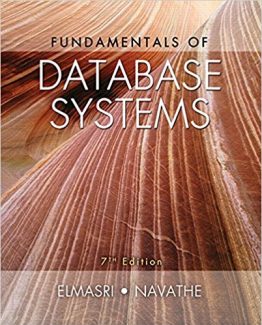JavaScript: The Definitive Guide: Master the World’s Most-Used Programming Language 7th Edition by David Flanagan, ISBN-13: 978-1491952023
[PDF eBook eTextbook] – Available Instantly
- Publisher: O’Reilly Media; 7th edition (June 23, 2020)
- Language: English
- 704 pages
- ISBN-10: 1491952024
- ISBN-13: 978-1491952023
JavaScript is the programming language of the web and is used by more software developers today than any other programming language. For nearly 25 years this best seller has been the go-to guide for JavaScript programmers. The seventh edition is fully updated to cover the 2020 version of JavaScript, and new chapters cover classes, modules, iterators, generators, Promises, async/await, and metaprogramming. You’ll find illuminating and engaging example code throughout.
This book is for programmers who want to learn JavaScript and for web developers who want to take their understanding and mastery to the next level. It begins by explaining the JavaScript language itself, in detail, from the bottom up. It then builds on that foundation to cover the web platform and Node.js.
Topics include:
- Types, values, variables, expressions, operators, statements, objects, and arrays
- Functions, classes, modules, iterators, generators, Promises, and async/await
- JavaScript’s standard library: data structures, regular expressions, JSON, i18n, etc.
- The web platform: documents, components, graphics, networking, storage, and threads
- Node.js: buffers, files, streams, threads, child processes, web clients, and web servers
- Tools and language extensions that professional JavaScript developers rely on.
The overwhelming majority of websites use JavaScript, and all modern web browsers—on desktops, tablets, and phones—include JavaScript interpreters, making JavaScript the most-deployed programming language in history. Over the last decade, Node.js has enabled JavaScript programming outside of web browsers, and the dramatic success of Node means that JavaScript is now also the most-used programming language among software developers. Whether you’re starting from scratch or are already using JavaScript professionally, this book will help you master the language.
If you are already familiar with other programming languages, it may help you to know that JavaScript is a high-level, dynamic, interpreted programming language that is well-suited to object-oriented and functional programming styles. JavaScript’s variables are untyped. Its syntax is loosely based on Java, but the languages are otherwise unrelated.
JavaScript derives its first-class functions from Scheme and its prototype-based inheritance from the little-known language Self. But you do not need to know any of those languages, or be familiar with those terms, to use this book and learn JavaScript.
Table of Contents:
Preface
Conventions Used in This Book
Example Code
O’Reilly Online Learning
How to Contact Us
Acknowledgments
Introduction to JavaScript
1.1 Exploring JavaScript
1.2 Hello World
1.3 A Tour of JavaScript
1.4 Example: Character Frequency Histograms
1.5 Summary
Lexical Structure
2.1 The Text of a JavaScript Program
2.2 Comments
2.3 Literals
2.4 Identifiers and Reserved Words
2.4.1 Reserved Words
2.5 Unicode
2.5.1 Unicode Escape Sequences
2.5.2 Unicode Normalization
2.6 Optional Semicolons
2.7 Summary
Types, Values, and Variables
3.1 Overview and Definitions
3.2 Numbers
3.2.1 Integer Literals
3.2.2 Floating-Point Literals
3.2.3 Arithmetic in JavaScript
3.2.4 Binary Floating-Point and Rounding Errors
3.2.5 Arbitrary Precision Integers with BigInt
3.2.6 Dates and Times
3.3 Text
3.3.1 String Literals
3.3.2 Escape Sequences in String Literals
3.3.3 Working with Strings
3.3.4 Template Literals
3.3.5 Pattern Matching
3.4 Boolean Values
3.5 null and undefined
3.6 Symbols
3.7 The Global Object
3.8 Immutable Primitive Values and Mutable Object References
3.9 Type Conversions
3.9.1 Conversions and Equality
3.9.2 Explicit Conversions
3.9.3 Object to Primitive Conversions
3.10 Variable Declaration and Assignment
3.10.1 Declarations with let and const
3.10.2 Variable Declarations with var
3.10.3 Destructuring Assignment
3.11 Summary
Expressions and Operators
4.1 Primary Expressions
4.2 Object and Array Initializers
4.3 Function Definition Expressions
4.4 Property Access Expressions
4.4.1 Conditional Property Access
4.5 Invocation Expressions
4.5.1 Conditional Invocation
4.6 Object Creation Expressions
4.7 Operator Overview
4.7.1 Number of Operands
4.7.2 Operand and Result Type
4.7.3 Operator Side Effects
4.7.4 Operator Precedence
4.7.5 Operator Associativity
4.7.6 Order of Evaluation
4.8 Arithmetic Expressions
4.8.1 The + Operator
4.8.2 Unary Arithmetic Operators
4.8.3 Bitwise Operators
4.9 Relational Expressions
4.9.1 Equality and Inequality Operators
4.9.2 Comparison Operators
4.9.3 The in Operator
4.9.4 The instanceof Operator
4.10 Logical Expressions
4.10.1 Logical AND (&&)
4.10.2 Logical OR (||)
4.10.3 Logical NOT (!)
4.11 Assignment Expressions
4.11.1 Assignment with Operation
4.12 Evaluation Expressions
4.12.1 eval()
4.12.2 Global eval()
4.12.3 Strict eval()
4.13 Miscellaneous Operators
4.13.1 The Conditional Operator (?:)
4.13.2 First-Defined (??)
4.13.3 The typeof Operator
4.13.4 The delete Operator
4.13.5 The await Operator
4.13.6 The void Operator
4.13.7 The comma Operator (,)
4.14 Summary
Statements
5.1 Expression Statements
5.2 Compound and Empty Statements
5.3 Conditionals
5.3.1 if
5.3.2 else if
5.3.3 switch
5.4 Loops
5.4.1 while
5.4.2 do/while
5.4.3 for
5.4.4 for/of
5.4.5 for/in
5.5 Jumps
5.5.1 Labeled Statements
5.5.2 break
5.5.3 continue
5.5.4 return
5.5.5 yield
5.5.6 throw
5.5.7 try/catch/finally
5.6 Miscellaneous Statements
5.6.1 with
5.6.2 debugger
5.6.3 “use strict”
5.7 Declarations
5.7.1 const, let, and var
5.7.2 function
5.7.3 class
5.7.4 import and export
5.8 Summary of JavaScript Statements
Objects
6.1 Introduction to Objects
6.2 Creating Objects
6.2.1 Object Literals
6.2.2 Creating Objects with new
6.2.3 Prototypes
6.2.4 Object.create()
6.3 Querying and Setting Properties
6.3.1 Objects As Associative Arrays
6.3.2 Inheritance
6.3.3 Property Access Errors
6.4 Deleting Properties
6.5 Testing Properties
6.6 Enumerating Properties
6.6.1 Property Enumeration Order
6.7 Extending Objects
6.8 Serializing Objects
6.9 Object Methods
6.9.1 The toString() Method
6.9.2 The toLocaleString() Method
6.9.3 The valueOf() Method
6.9.4 The toJSON() Method
6.10 Extended Object Literal Syntax
6.10.1 Shorthand Properties
6.10.2 Computed Property Names
6.10.3 Symbols as Property Names
6.10.4 Spread Operator
6.10.5 Shorthand Methods
6.10.6 Property Getters and Setters
6.11 Summary
Arrays
7.1 Creating Arrays
7.1.1 Array Literals
7.1.2 The Spread Operator
7.1.3 The Array() Constructor
7.1.4 Array.of()
7.1.5 Array.from()
7.2 Reading and Writing Array Elements
7.3 Sparse Arrays
7.4 Array Length
7.5 Adding and Deleting Array Elements
7.6 Iterating Arrays
7.7 Multidimensional Arrays
7.8 Array Methods
7.8.1 Array Iterator Methods
7.8.2 Flattening arrays with flat() and flatMap()
7.8.3 Adding arrays with concat()
7.8.4 Stacks and Queues with push(), pop(), shift(), and unshift()
7.8.5 Subarrays with slice(), splice(), fill(), and copyWithin()
7.8.6 Array Searching and Sorting Methods
7.8.7 Array to String Conversions
7.8.8 Static Array Functions
7.9 Array-Like Objects
7.10 Strings as Arrays
7.11 Summary
Functions
8.1 Defining Functions
8.1.1 Function Declarations
8.1.2 Function Expressions
8.1.3 Arrow Functions
8.1.4 Nested Functions
8.2 Invoking Functions
8.2.1 Function Invocation
8.2.2 Method Invocation
8.2.3 Constructor Invocation
8.2.4 Indirect Invocation
8.2.5 Implicit Function Invocation
8.3 Function Arguments and Parameters
8.3.1 Optional Parameters and Defaults
8.3.2 Rest Parameters and Variable-Length Argument Lists
8.3.3 The Arguments Object
8.3.4 The Spread Operator for Function Calls
8.3.5 Destructuring Function Arguments into Parameters
8.3.6 Argument Types
8.4 Functions as Values
8.4.1 Defining Your Own Function Properties
8.5 Functions as Namespaces
8.6 Closures
8.7 Function Properties, Methods, and Constructor
8.7.1 The length Property
8.7.2 The name Property
8.7.3 The prototype Property
8.7.4 The call() and apply() Methods
8.7.5 The bind() Method
8.7.6 The toString() Method
8.7.7 The Function() Constructor
8.8 Functional Programming
8.8.1 Processing Arrays with Functions
8.8.2 Higher-Order Functions
8.8.3 Partial Application of Functions
8.8.4 Memoization
8.9 Summary
Classes
9.1 Classes and Prototypes
9.2 Classes and Constructors
9.2.1 Constructors, Class Identity, and instanceof
9.2.2 The constructor Property
9.3 Classes with the class Keyword
9.3.1 Static Methods
9.3.2 Getters, Setters, and other Method Forms
9.3.3 Public, Private, and Static Fields
9.3.4 Example: A Complex Number Class
9.4 Adding Methods to Existing Classes
9.5 Subclasses
9.5.1 Subclasses and Prototypes
9.5.2 Subclasses with extends and super
9.5.3 Delegation Instead of Inheritance
9.5.4 Class Hierarchies and Abstract Classes
9.6 Summary
Modules
10.1 Modules with Classes, Objects, and Closures
10.1.1 Automating Closure-Based Modularity
10.2 Modules in Node
10.2.1 Node Exports
10.2.2 Node Imports
10.2.3 Node-Style Modules on the Web
10.3 Modules in ES6
10.3.1 ES6 Exports
10.3.2 ES6 Imports
10.3.3 Imports and Exports with Renaming
10.3.4 Re-Exports
10.3.5 JavaScript Modules on the Web
10.3.6 Dynamic Imports with import()
10.3.7 import.meta.url
10.4 Summary
The JavaScript Standard Library
11.1 Sets and Maps
11.1.1 The Set Class
11.1.2 The Map Class
11.1.3 WeakMap and WeakSet
11.2 Typed Arrays and Binary Data
11.2.1 Typed Array Types
11.2.2 Creating Typed Arrays
11.2.3 Using Typed Arrays
11.2.4 Typed Array Methods and Properties
11.2.5 DataView and Endianness
11.3 Pattern Matching with Regular Expressions
11.3.1 Defining Regular Expressions
11.3.2 String Methods for Pattern Matching
11.3.3 The RegExp Class
11.4 Dates and Times
11.4.1 Timestamps
11.4.2 Date Arithmetic
11.4.3 Formatting and Parsing Date Strings
11.5 Error Classes
11.6 JSON Serialization and Parsing
11.6.1 JSON Customizations
11.7 The Internationalization API
11.7.1 Formatting Numbers
11.7.2 Formatting Dates and Times
11.7.3 Comparing Strings
11.8 The Console API
11.8.1 Formatted Output with Console
11.9 URL APIs
11.9.1 Legacy URL Functions
11.10 Timers
11.11 Summary
Iterators and Generators
12.1 How Iterators Work
12.2 Implementing Iterable Objects
12.2.1 “Closing” an Iterator: The Return Method
12.3 Generators
12.3.1 Generator Examples
12.3.2 yield* and Recursive Generators
12.4 Advanced Generator Features
12.4.1 The Return Value of a Generator Function
12.4.2 The Value of a yield Expression
12.4.3 The return() and throw() Methods of a Generator
12.4.4 A Final Note About Generators
12.5 Summary
Asynchronous JavaScript
13.1 Asynchronous Programming with Callbacks
13.1.1 Timers
13.1.2 Events
13.1.3 Network Events
13.1.4 Callbacks and Events in Node
13.2 Promises
13.2.1 Using Promises
13.2.2 Chaining Promises
13.2.3 Resolving Promises
13.2.4 More on Promises and Errors
13.2.5 Promises in Parallel
13.2.6 Making Promises
13.2.7 Promises in Sequence
13.3 async and await
13.3.1 await Expressions
13.3.2 async Functions
13.3.3 Awaiting Multiple Promises
13.3.4 Implementation Details
13.4 Asynchronous Iteration
13.4.1 The for/await Loop
13.4.2 Asynchronous Iterators
13.4.3 Asynchronous Generators
13.4.4 Implementing Asynchronous Iterators
13.5 Summary
Metaprogramming
14.1 Property Attributes
14.2 Object Extensibility
14.3 The prototype Attribute
14.4 Well-Known Symbols
14.4.1 Symbol.iterator and Symbol.asyncIterator
14.4.2 Symbol.hasInstance
14.4.3 Symbol.toStringTag
14.4.4 Symbol.species
14.4.5 Symbol.isConcatSpreadable
14.4.6 Pattern-Matching Symbols
14.4.7 Symbol.toPrimitive
14.4.8 Symbol.unscopables
14.5 Template Tags
14.6 The Reflect API
14.7 Proxy Objects
14.7.1 Proxy Invariants
14.8 Summary
JavaScript in Web Browsers
15.1 Web Programming Basics
15.1.1 JavaScript in HTML <script> Tags
15.1.2 The Document Object Model
15.1.3 The Global Object in Web Browsers
15.1.4 Scripts Share a Namespace
15.1.5 Execution of JavaScript Programs
15.1.6 Program Input and Output
15.1.7 Program Errors
15.1.8 The Web Security Model
15.2 Events
15.2.1 Event Categories
15.2.2 Registering Event Handlers
15.2.3 Event Handler Invocation
15.2.4 Event Propagation
15.2.5 Event Cancellation
15.2.6 Dispatching Custom Events
15.3 Scripting Documents
15.3.1 Selecting Document Elements
15.3.2 Document Structure and Traversal
15.3.3 Attributes
15.3.4 Element Content
15.3.5 Creating, Inserting, and Deleting Nodes
15.3.6 Example: Generating a Table of Contents
15.4 Scripting CSS
15.4.1 CSS Classes
15.4.2 Inline Styles
15.4.3 Computed Styles
15.4.4 Scripting Stylesheets
15.4.5 CSS Animations and Events
15.5 Document Geometry and Scrolling
15.5.1 Document Coordinates and Viewport Coordinates
15.5.2 Querying the Geometry of an Element
15.5.3 Determining the Element at a Point
15.5.4 Scrolling
15.5.5 Viewport Size, Content Size, and Scroll Position
15.6 Web Components
15.6.1 Using Web Components
15.6.2 HTML Templates
15.6.3 Custom Elements
15.6.4 Shadow DOM
15.6.5 Example: a <search-box> Web Component
15.7 SVG: Scalable Vector Graphics
15.7.1 SVG in HTML
15.7.2 Scripting SVG
15.7.3 Creating SVG Images with JavaScript
15.8 Graphics in a <canvas>
15.8.1 Paths and Polygons
15.8.2 Canvas Dimensions and Coordinates
15.8.3 Graphics Attributes
15.8.4 Canvas Drawing Operations
15.8.5 Coordinate System Transforms
15.8.6 Clipping
15.8.7 Pixel Manipulation
15.9 Audio APIs
15.9.1 The Audio() Constructor
15.9.2 The WebAudio API
15.10 Location, Navigation, and History
15.10.1 Loading New Documents
15.10.2 Browsing History
15.10.3 History Management with hashchange Events
15.10.4 History Management with pushState()
15.11 Networking
15.11.1 fetch()
15.11.2 Server-Sent Events
15.11.3 WebSockets
15.12 Storage
15.12.1 localStorage and sessionStorage
15.12.2 Cookies
15.12.3 IndexedDB
15.13 Worker Threads and Messaging
15.13.1 Worker Objects
15.13.2 The Global Object in Workers
15.13.3 Importing Code into a Worker
15.13.4 Worker Execution Model
15.13.5 postMessage(), MessagePorts, and MessageChannels
15.13.6 Cross-Origin Messaging with postMessage()
15.14 Example: The Mandelbrot Set
15.15 Summary and Suggestions for Further Reading
15.15.1 HTML and CSS
15.15.2 Performance
15.15.3 Security
15.15.4 WebAssembly
15.15.5 More Document and Window Features
15.15.6 Events
15.15.7 Progressive Web Apps and Service Workers
15.15.8 Mobile Device APIs
15.15.9 Binary APIs
15.15.10 Media APIs
15.15.11 Cryptography and Related APIs
Server-Side JavaScript with Node
16.1 Node Programming Basics
16.1.1 Console Output
16.1.2 Command-Line Arguments and Environment Variables
16.1.3 Program Life Cycle
16.1.4 Node Modules
16.1.5 The Node Package Manager
16.2 Node Is Asynchronous by Default
16.3 Buffers
16.4 Events and EventEmitter
16.5 Streams
16.5.1 Pipes
16.5.2 Asynchronous Iteration
16.5.3 Writing to Streams and Handling Backpressure
16.5.4 Reading Streams with Events
16.6 Process, CPU, and Operating System Details
16.7 Working with Files
16.7.1 Paths, File Descriptors, and FileHandles
16.7.2 Reading Files
16.7.3 Writing Files
16.7.4 File Operations
16.7.5 File Metadata
16.7.6 Working with Directories
16.8 HTTP Clients and Servers
16.9 Non-HTTP Network Servers and Clients
16.10 Working with Child Processes
16.10.1 execSync() and execFileSync()
16.10.2 exec() and execFile()
16.10.3 spawn()
16.10.4 fork()
16.11 Worker Threads
16.11.1 Creating Workers and Passing Messages
16.11.2 The Worker Execution Environment
16.11.3 Communication Channels and MessagePorts
16.11.4 Transferring MessagePorts and Typed Arrays
16.11.5 Sharing Typed Arrays Between Threads
16.12 Summary
JavaScript Tools and Extensions
17.1 Linting with ESLint
17.2 JavaScript Formatting with Prettier
17.3 Unit Testing with Jest
17.4 Package Management with npm
17.5 Code Bundling
17.6 Transpilation with Babel
17.7 JSX: Markup Expressions in JavaScript
17.8 Type Checking with Flow
17.8.1 Installing and Running Flow
17.8.2 Using Type Annotations
17.8.3 Class Types
17.8.4 Object Types
17.8.5 Type Aliases
17.8.6 Array Types
17.8.7 Other Parameterized Types
17.8.8 Read-Only Types
17.8.9 Function Types
17.8.10 Union Types
17.8.11 Enumerated Types and Discriminated Unions
17.9 Summary
Index
What makes us different?
• Instant Download
• Always Competitive Pricing
• 100% Privacy
• FREE Sample Available
• 24-7 LIVE Customer Support





